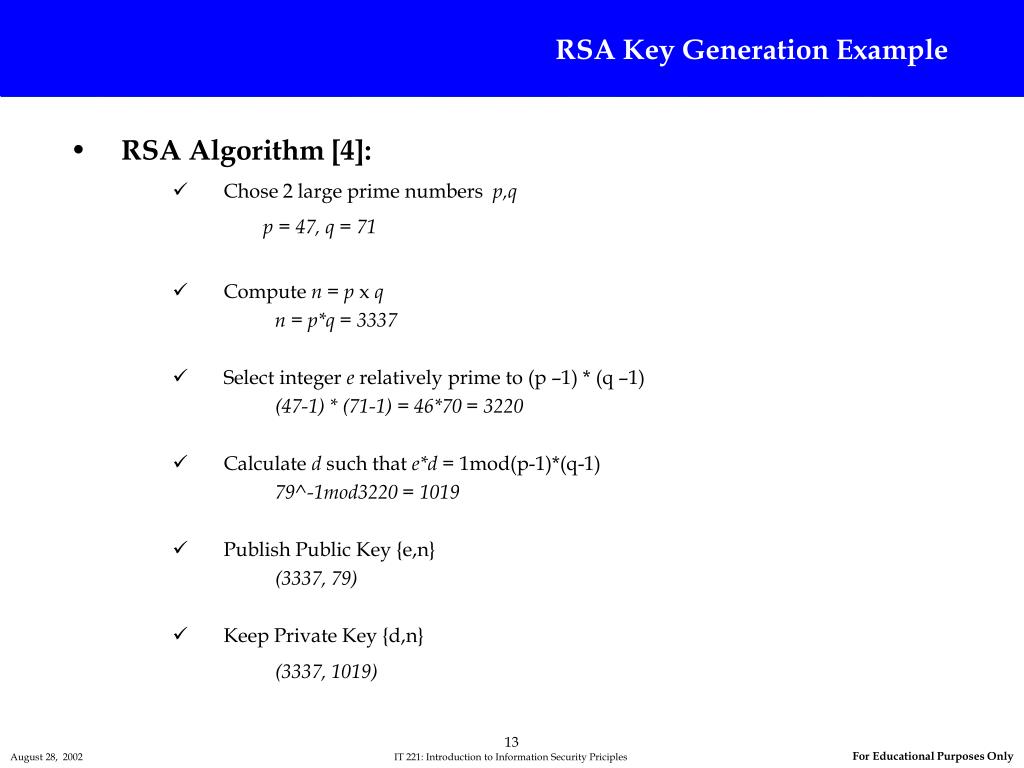Java Rsa Key Generation Example
Contents
The following are top voted examples for showing how to use java.security.KeyPairGenerator.These examples are extracted from open source projects. You can vote up the examples you like and your votes will be used in our system to generate more good examples. Key Generation. In lecture, we learned about RSA and how to implement RSA key generation in Java using the fields and methods of the BigInteger class. Problem 2: Write a Java method keyGenerate selects an n and calculates the values of k and d. Make two copies of your prelab code. Submit one copy to your Lab TA at the beginning of lab session. Example of RSA generation, sign, verify, encryption, decryption and keystores in Java - RsaExample.java.
- Apr 23, 2012 Generating a RSA Key with the Java Keytool. Use the Java keytool to create public and private keys for RSA authentication if the client is in Java. RSA authentication uses public and private keys instead of passwords to authenticate with the ESP Server.
- The Java KeyPairGenerator class (java.security.KeyPairGenerator) is used to generate asymmetric encryption / decryption key pairs.An asymmetric key pair consists of two keys. The first key is typically used to encrypt data. The second key which is used to decrypt data encrypted with the first key.
- Feb 02, 2013 Java Code for RSA Key Generation. Java Code for RSA Key Generation. Skip navigation Sign in. How SSL works tutorial - with HTTPS example - Duration: 11:09. Tubewar 1,569,176 views.
- 3. Saving the Keys in Binary Format
- Source Code
1. Introduction

Let us learn the basics of generating and using RSA keys in Java.
Java provides classes for the generation of RSA public and private key pairs with the package java.security. You can use RSA keys pairs in public key cryptography.
Public key cryptography uses a pair of keys for encryption. Distribute the public key to whoever needs it but safely secure the private key.
Public key cryptography can be used in two modes:
Encryption: Only the private key can decrypt the data encrypted with the public key.
Authentication: Data encrypted with the private key can only be decrypted with the public key thus proving who the data came from.
2. Generating a Key Pair
First step in creating an RSA Key Pair is to create a KeyPairGeneratorfrom a factory method by specifying the algorithm (“RSA” in this instance):
Initialize the KeyPairGenerator with the key size. Use a key size of 1024 or 2048. Currently recommended key size for SSL certificates used in e-commerce is 2048 so that is what we use here.
From the KeyPair object, get the public key using getPublic() and the private key using getPrivate().
3. Saving the Keys in Binary Format
Save the keys to hard disk once they are obtained. This allows re-using the keys for encryption, decryption and authentication.
What is the format of the saved files? The key information is encoded in different formats for different types of keys. Here is how you can find what format the key was saved in. On my machine, the private key was saved in PKCS#8 format and the public key in X.509 format. We need this information below to load the keys.
3.1. Load Private Key from File
After saving the private key to a file (or a database), you might need to load it at a later time. You can do that using the following code. Note that you need to know what format the data was saved in: PKCS#8 in our case.
3.2 Load Public Key from File
Rsa Key Generation Algorithm
Load the public key from a file as follows. The public key has been saved in X.509 format so we use the X509EncodedKeySpec class to convert it.
4. Use Base64 for Saving Keys as Text
Save the keys in text format by encoding the data in Base64. Java 8 provides a Base64 class which can be used for the purpose. Save the private key with a comment as follows:
And the public key too (with a comment):
5. Generating a Digital Signature
As mentioned above, one of the purposes of public key cryptography is digital signature i.e. you generate a digital signature from a file contents, sign it with your private key and send the signature along with the file. The recipient can then use your public key to verify that the signature matches the file contents.
Here is how you can do it. Use the signature algorithm “SHA256withRSA” which is guaranteed to be supported on all JVMs. The last of us beta key generator free download software. Use the private key (either generated or load from file as shown above) to initialize the Signatureobject for signing. It is then updated with contents from the data file and the signature is generated and written to the output file. This output file contains the digital signature and must be sent to the recipient for verification.
6. Verifying the Digital Signature
The recipient uses the digital signature sent with a data file to verify that the data file has not been tampered with. It requires access to the sender’s public key and can be loaded from a file if necessary as presented above.
The code below updates the Signature object with data from the data file. It then loads the signature from file and uses Signature.verify() to check if the signature is valid.
And that in a nutshell is how you can use RSA public and private keys for digital signature and verification.
Rsa Key Generation Example
Source Code
Java Rsa Key Generation Example For Students
Go here for the source code.